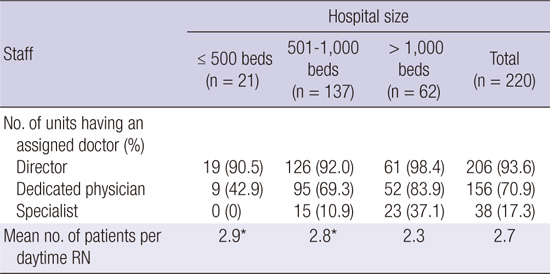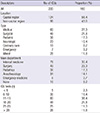1. Kim JH, Hong SK, Kim KC, Lee MG, Lee KM, Jung SS, Choi HS, Lee JH, Jung KS, Lee SS, et al. Influence of full-time intensivist and the nurse-to-patient ratio on the implementation of severe sepsis bundles in Korean intensive care units. J Crit Care. 2012; 27:414.e11–414.e21.
2. Wunsch H, Angus DC, Harrison DA, Collange O, Fowler R, Hoste EA, de Keizer NF, Kersten A, Linde-Zwirble WT, Sandiumenge A, et al. Variation in critical care services across North America and Western Europe. Crit Care Med. 2008; 36:2787–2793.e1-9.
3. Kang CH, Kim YI, Lee EJ, Park K, Lee JS, Kim Y. The variation in risk adjusted mortality of intensive care units. Korean J Anesthesiol. 2009; 57:698–703.
4. Stone PW, Mooney-Kane C, Larson EL, Horan T, Glance LG, Zwanziger J, Dick AW. Nurse working conditions and patient safety outcomes. Med Care. 2007; 45:571–578.
5. Cho SH, Hwang JH, Kim J. Nurse staffing and patient mortality in intensive care units. Nurs Res. 2008; 57:322–330.
6. Sales A, Sharp N, Li YF, Lowy E, Greiner G, Liu CF, Alt-White A, Rick C, Sochalski J, Mitchell PH, et al. The association between nursing factors and patient mortality in the Veterans Health Administration: the view from the nursing unit level. Med Care. 2008; 46:938–945.
7. Blot SI, Serra ML, Koulenti D, Lisboa T, Deja M, Myrianthefs P, Manno E, Diaz E, Topeli A, Martin-Loeches I, et al. Patient to nurse ratio and risk of ventilator-associated pneumonia in critically ill patients. Am J Crit Care. 2011; 20:e1–e9.
8. Hugonnet S, Uckay I, Pittet D. Staffing level: a determinant of late-onset ventilator-associated pneumonia. Crit Care. 2007; 11:R80.
9. Bray K, Wren I, Baldwin A, St Ledger U, Gibson V, Goodman S, Walsh D. Standards for nurse staffing in critical care units determined by: the British Association of Critical Care Nurses, the Critical Care Networks National Nurse Leads, Royal College of Nursing Critical Care and In-flight Forum. Nurs Crit Care. 2010; 15:109–111.
10. Hartigan RC. The Synergy Model: establishing criteria for 1:1 staffing ratios. Crit Care Nurse. 2000; 20:112114–116.
11. Sirio CA, Tajimi K, Taenaka N, Ujike Y, Okamoto K, Katsuya H. A cross-cultural comparison of critical care delivery: Japan and the United States. Chest. 2002; 121:539–548.
12. Mallick R, Strosberg M, Lambrinos J, Groeger JS. The intensive care unit medical director as manager: impact on performance. Med Care. 1995; 33:611–624.
13. Pronovost PJ, Angus DC, Dorman T, Robinson KA, Dremsizov TT, Young TL. Physician staffing patterns and clinical outcomes in critically ill patients: a systematic review. JAMA. 2002; 288:2151–2162.
14. Treggiari MM, Martin DP, Yanez ND, Caldwell E, Hudson LD, Rubenfeld GD. Effect of intensive care unit organizational model and structure on outcomes in patients with acute lung injury. Am J Respir Crit Care Med. 2007; 176:685–690.
15. Dimick JB, Pronovost PJ, Heitmiller RF, Lipsett PA. Intensive care unit physician staffing is associated with decreased length of stay, hospital cost, and complications after esophageal resection. Crit Care Med. 2001; 29:753–758.
16. Pronovost PJ, Jenckes MW, Dorman T, Garrett E, Breslow MJ, Rosenfeld BA, Lipsett PA, Bass E. Organizational characteristics of intensive care units related to outcomes of abdominal aortic surgery. JAMA. 1999; 281:1310–1317.
17. Suarez JI, Zaidat OO, Suri MF, Feen ES, Lynch G, Hickman J, Georgiadis A, Selman WR. Length of stay and mortality in neurocritically ill patients: impact of a specialized neurocritical care team. Crit Care Med. 2004; 32:2311–2317.
18. Gajic O, Afessa B, Hanson AC, Krpata T, Yilmaz M, Mohamed SF, Rabatin JT, Evenson LK, Aksamit TR, Peters SG, et al. Effect of 24-hour mandatory versus on-demand critical care specialist presence on quality of care and family and provider satisfaction in the intensive care unit of a teaching hospital. Crit Care Med. 2008; 36:36–44.
19. Haupt MT, Bekes CE, Brilli RJ, Carl LC, Gray AW, Jastremski MS, Naylor DF, PharmD MR, Md AS, Wedel SK, et al. Guidelines on critical care services and personnel: recommendations based on a system of categorization of three levels of care. Crit Care Med. 2003; 31:2677–2683.
20. Judson JA, Fisher MM. Intensive care in Australia and New Zealand. Crit Care Clin. 2006; 22:407–423.
21. Offenstadt G, Moreno R, Palomar M, Gullo A. Intensive care medicine in Europe. Crit Care Clin. 2006; 22:425–432.
22. Angus DC, Kelley MA, Schmitz RJ, White A, Popovich J Jr. Committee on Manpower for Pulmonary and Critical Care Societies (COMPACCS). Caring for the critically ill patient: current and projected workforce requirements for care of the critically ill and patients with pulmonary disease: can we meet the requirements of an aging population? JAMA. 2000; 284:2762–2770.





 PDF
PDF ePub
ePub Citation
Citation Print
Print













 XML Download
XML Download